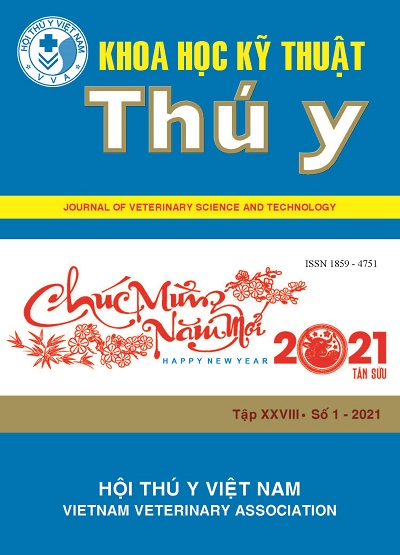Situation of parasitic helminth infection in Cylindrophis ruffus and Enhydris enhydris snakes in Dong Thap province
Abstract
Study on the helminth species parasited in the wildlife Cylindrophis ruffus and Enhydris enhydris snakes in Dong Thap province was conducted from January 2019 to January 2020. The autopsy method and classifying identification for helminth species based on their parasitic location, appearance, size, external and internal morphology were used. Out of a total of 160 snakes (80 Cylindrophis ruffus
and 80 Enhydris enhydris snakes) were examined, there were 150 snakes infected with helminths with an average rate of 93.75% (95% of Cylindrophis ruffus snakes and 92.50% of Enhydris enhydris snakes). Meanwhile, the Cylindroids ruffus snakes were infected with 3 helminth classes, of which the infection rate with Cestoda class (tapeworms) was highest (60.00%), followed by Trematoda class (flukes): 30.00% and Nematoda class (round worms): 22.50%. The Cylindrophis ruffus snakes were infected with 8 helminth species: 4 species of Trematoda class with the infection rates Proctoces sp. (27.50%), Haplometroides buccicola (7.50%), Singhiatrema vietnamenses (15.00%) and Travtrema
stenocotyle (12.50%); 3 species of Cestoda class (tapeworms) with the infection rates Mesocestoides sp. (32.50%), Autralotaenia bunthangi (32.50%) and Spathebothriidea sp. (17.50%), and one species
of class Nematoda (roundworms) was Ophidascaris durissus with the infection rate 22.50%. The Enhydris enhydris snakes were infected with 2 helminth classes, the infection rate with Trematoda class was 92.50%, and with Cestoda class (tapeworms) was 10%, the snakes infected with Nematoda was not found. There were 8 helminth species found on the Enhydris enhydris snakes, of which 5 helminth species belong to Trematoda class (fluke), with the infection rate Haplometroides buccicola (70.00%), Singhiatrema vietnamenses (57.50%), Travtrema stencotyle (37.50%), Platynosomum sp.(25.00%) and Proctoces sp. (10.00%) and 3 species of class Cestoda (tapeworms), with the infection
rate Autralotaenia bunthangi (10.00%), Spathebothriidea sp. (5.00%) and Mesocestoides sp. (2.50%). Among the helminth species were found in two snake species, Platynosomum sp. and Mesocestoides
sp. could be transmissible to human.

